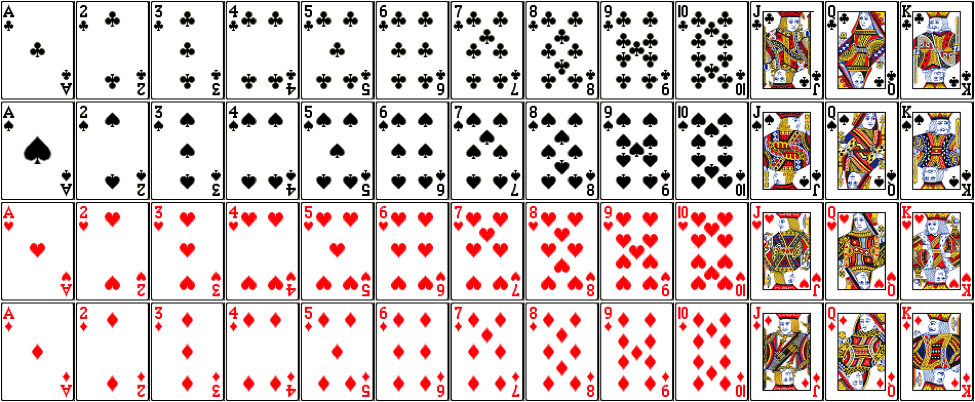Introduction to Probability Models
Lecture 2
Qi Wang, Department of Statistics
Aug 22, 2018
Example 1
Consider a standard deck of 52 playing cards. You will draw one card out of a thoroughly shuffled deck of cards.
 Define the following events: H = the suit is a heart, R = the card is red, F = the card is a face card (i.e. Jack, Queen or King)
Define the following events: H = the suit is a heart, R = the card is red, F = the card is a face card (i.e. Jack, Queen or King)
- Determine which of these events are subsets of each other?
- Are any of these sets complements of each other? Describe what would be in $H^c$? In $R^c$?
- What are the chances that you will draw out a spade? A seven? A red jack?
Probability
- Probability: the chance or likelihood of a random event occuring
- Equally likely framework: know all possible outcomes and each outcomes is equally likely $P(E) = \frac{\#OutcomesInEvent}{\#OutcomesInSampleSpace} = \frac{N(E)}{N(\Omega)}$
- Frequentist interpretation of probability: probability is the long run proportion of times event occurs in independent repetitions of random experiment $$P(E) = \frac{N(E)}{n}$$ $n$ is sample size and $n$ is large
- Probability that a student is wearing blue jeans?
- Probability that in a roll of a die you will get a 5?
- Probability that it will snow in January?
Probability Rules
- Any probability must be between 0 and 1(inclusive), $0 \le p \le 1$
- Sum of probability of all outcomes in $\Omega$ must equal to 1, $P(\Omega) = 1, \sum_{i=1}^n p_i = 1$
- probability of event is the sum of probability of the specific outcomes in that event
Example 2
Your friend tells you the following probabilities for a weighted die. You will roll the die one time.
| Die Roll(X) | 1 | 2 | 3 | 4 | 5 | 6 |
| Probability | 0.5 | 0.1 | 0.1 | 0.1 | 0.1 | 0.1 |
- Is this a legitimate probability model?
- What is the probability of rolling a 4 or higher?
- What is the probability of rolling an even number?
Example 3
A fair six-sided die is rolled twice

- Write out the sample space using correct notation
- Define the following events:
- J = the two rolls are the same number;
- K = the sum of the rolls is at least 4;
- L = the sum of the rolls is 7.
- What is $P(K^c)$?
Venn Diagrams
- Venn Diagrams: a diagram that shows all possible logical relations between a finite collection of different sets. They are useful tools for visualizing probability models
- Intersection of events A and B consists of those outcomes that are in BOTH event A and in event B, denoted by
$A\cap B$, $\cap = $ intersection
![]()
- Union of events A and B consists of those outcomes that in either event A or in event B or in BOTH, denoted by
$A\cup B$, $\cup = $ union
![]()
- NOTE: both intersections and unions can be determined for 3 or more events.
Example 3 Continued
- Find $P(J\cap K)$; $P(J\cap L)$; $P(K \cap L)$
- Find $P(J\cup K)$; $P(J\cup L)$; $P(K \cup L)$
- Find $P(J\cap L^c )$.
Definitions
- Mutually Exclusive(disjoint): $A\cap B = \emptyset$
- Exhaustive: $A \cup B = \Omega$
- Partition:
- $A\cap B = \emptyset$
- $A \cup B = \Omega$
More Probability Law and Rules
- $P(\Omega) = 1, P(\emptyset) = 0$
- Associative Laws:
- $A\cap (B\cap C) = (A\cap B)\cap C$
- $A\cup (B\cup C) = (A\cup B)\cup C$
-
Commutative Laws:
- $A \cap B = B \cap A$
- $A \cup B = B \cup A$
- Distributive Laws:
- $A \cap (B\cap C) = (A\cap B) \cup (A \cap C)$
- $A \cup (B \cap C) = (A\cup B) \cap (A \cup C)$
- Complement Rule: $P(A^c) = 1 - P(A)$
- General Additive Rule: $P(A\cup B) = P(A) + P(B) - P(A\cap B)$

